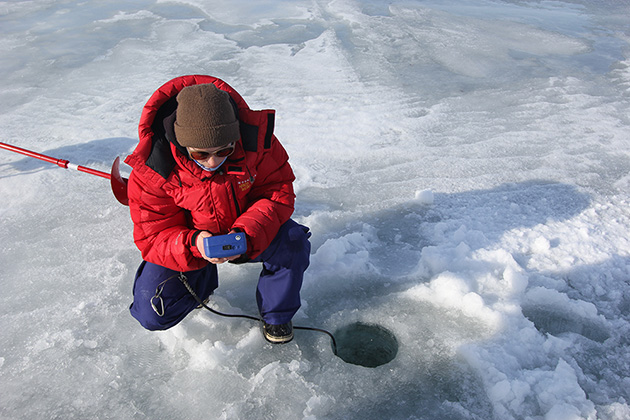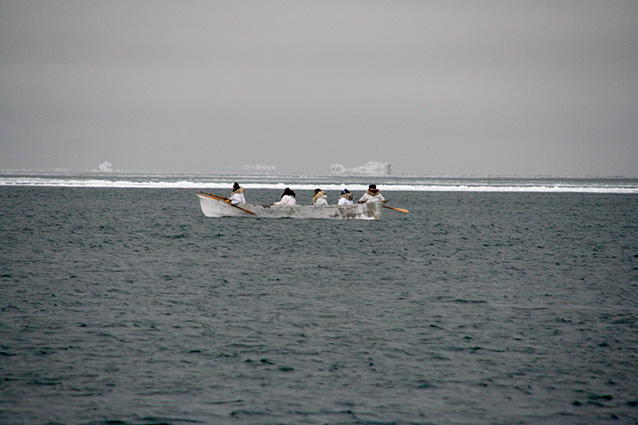Sea ice is the thin floating skin that forms on the surface of the ocean as it freezes. Though few of us encounter sea ice in our daily lives, the shrinking and thinning of the Arctic ice pack as a result of regional warming has global implications that will be felt by all of us. Sea ice plays a fundamental role in the global climate system (Barry et al. 1993) and provides critical habitat for a wide range of species (Laidre et al. 2015, Melnikov et al. 2001). At the same time, the increasing extent of open water in summer is making its mark on offshore oil exploration and development, global shipping routes, and the geopolitical landscape in the North (Blunden 2012). However, for those people who live at the shores of the Arctic Ocean, sea ice is more than just a component of the global climate and ecosystems, or a subject of discussion in boardrooms and conferences. For Inuit, the shrinking Arctic ice pack is changing a way of life that relies on sea ice as a source of food and clothing and a place to call home (Gearheard et al. 2013, ICC 2015).

Photo courtesy of Trevor Haynes, Wildlife Conservation Society
Over the last three decades, satellite records show that the amount of sea ice in the Arctic Ocean at the end of summer has decreased by approximately 40% (Serreze and Stroeve 2015), exposing an area of previously ice-covered ocean one and a half times the size of Alaska.
Historical observations recorded in ice charts and ship log books indicate that this loss of ice is unprecedented in at least 150 years (Mahoney et al. 2011 and 2008). Sea ice helps keep the Polar Regions cool by reflecting the majority of solar energy back into the atmosphere. Thus, any reduction in ice extent creates a self-reinforcing cycle whereby the retreating ice edge exposes more ocean during the summer, allowing more heat to be absorbed, which accelerates the loss of ice and rate of warming. Scientists call this process the “ice-albedo-feedback” (Perovich et al. 2007). Partly due to the loss of sea ice in the North, the Arctic has warmed on average by 0.6 °C (1.1 °F) per decade (Comiso and Hall 2014), faster than any other region on Earth. The loss of sea ice also has profound ecological implications that extend well beyond the Arctic.
The seasonal expansion and contraction of the ice pack sets an annual rhythm to the ecology of the Polar Regions and the Inuit way of life. At the beginning of each winter, new ice forms around the margins of the old and the ice-covered area of the ocean grows. The southward advance of the ice edge has annually driven most of the summer visitors away leaving behind only those species adapted to the polar winter. For example, ringed seals and polar bears have remained while walrus, bowhead whales, and guillemots migrate southward with the ice edge. These differences in behavior are becoming increasingly blurry as winter ice conditions ameliorate. Conversely, in spring when the ice retreats north, it has historically provided a platform for tens of thousands of female walrus and their calves during summer. Now with the ice retreating so far north, it lays over waters too deep for them to forage. These female walrus and their calves now come ashore in vast congregations that endanger the young animals that can be trampled as the herd comes and goes.
In addition to the charismatic wildlife so visible on and around sea ice, pockets of liquid brine trapped within sea ice provide a winter habitat for ice algae. Sheltered from grazing krill and located at the top of the water column, these algae are positioned at the front of the line ready to take advantage of the sunlight when it returns in spring. Released by melt into nutrient-rich waters, the algae multiply rapidly and provide the foundation of a food chain that supports the entire Arctic Ocean ecosystem (Arrigo et al. 2008). The life cycles of the Arctic’s year-round residents and its migratory summer visitors are timed to take advantage of this seasonal pulse of food. Thus, when female polar bears emerge from their dens with cubs, they feed on seals fattened by fish that eat the krill that thrive on the algae, which also feed the bowhead whales during their migration to their summer feeding grounds. In fact, the algal bloom that accompanies the retreating ice edge is so abundant that its leftovers nourish the seafloor, supporting vast populations of clams that are gorged on by bottom-feeding walrus.
All of these relationships between life and ice are well known to the Inuit, whose subsistence activities have long been timed to take advantage of this abundance (Gearheard et al. 2013). The close connection with sea ice places the Inuit on the frontlines of rapid Arctic change. Indeed, they are at the forefront of observing and experiencing the repercussions of these changes. Furthermore, a long history of traditional ecological knowledge about sea ice presents a rich context for the suite of contemporary changes affecting their own uses as well as that of the wildlife they rely on for food security.

Photo courtesy of Andrew Mahoney

Photo courtesy of Andrew Mahoney
The emergence of new weather patterns, species assemblages, and behaviors have all been astutely observed and increasingly documented by local experts (Krupnik 2010, Krupnik and Jolly 2002, Gearheard et al. 2006). In concert, residents of Arctic coastal communities are facing impacts related to the changes that directly affect their traditional way of life. For example, the delayed formation of sea ice in fall is leading to increased wave energy reaching the coast during storms, resulting in increased erosion of village sites (ACIA 2005). At the same time, the reduced stability of shore-fast ice increases the risk of detachment and endangerment of hunters during the spring hunting season (Druckenmiller et al. 2013), while the early onset of the spring melt is shortening the ice-based hunting season and impacting the health of ice-dependent seals (Gearheard et al. 2006).
While these changes in sea ice may bring some new opportunities for local communities (e.g., new species assemblages including more temperate whales and salmon, or new industries), the current pace of change is without recent precedent and poses significant challenges for effective adaptation. Current models predict that the Arctic will experience effectively ice-free summers (<1 million square kilometers) as early as 2040 (Wang and Overland 2012). Understanding and planning for the impacts of this will require science that responds to the priorities of local communities and incorporates the expertise of their indigenous knowledge holders. By doing so, we may help support the resilience of local communities and the iconic wildlife of the Arctic.
References
Arctic Climate Impact Assessment (ACIA). 2005.
Arctic Climate Impact Assessment—Scientific report. Cambridge: Cambridge University Press.
Arrigo, K. R., G. van Dijken, and S. Pabi. 2008.
Impact of a shrinking Arctic ice cover on marine primary production. Geophysical Research Letters 35(19).
Barry, R. G., M. C. Serreze, J. A. Maslanik, and R. H. Preller. 1993.
The Arctic Sea-Ice Climate System - Observations and Modeling. Reviews of Geophysics 31(4):397-422.
Blunden, M. 2012.
Geopolitics and the Northern Sea Route. International Affairs 88(1):115-129.
Comiso, J. C. and D. K. Hall. 2014.
Climate trends in the Arctic as observed from space. Wiley Interdisciplinary Reviews: Climate Change 5(3):389-409.
Druckenmiller, M. L., H. Eicken, J. C. C. George, and L. Brower. 2013.
Trails to the whale: Reflections of change and choice on an Iñupiat icescape at Barrow, Alaska. Polar Geography 36(1-2):5-29.
Gearheard, S., L. Kielsen Holm, H. P. Huntington, J. Leavitt, A. R. Mahoney, M. Opie, T. Oshima, and J. Sanguya, eds. 2013.
The Meaning of Ice: People and Sea Ice in Three Arctic Communities. International Polar Institute: Hanover, New Hampshire. 365pp.
Gearheard, S., W. Matumeak, I. Angutikjuaq, J. Maslanik, H. P. Huntington, J. Leavitt, D. M. Kagak, G. Tigullaraq, and R. G. Barry. 2006.
“It’s not that simple:” A collaborative comparison of sea ice environments, their uses, observed changes, and adaptations in barrow, Alaska, USA, and Clyde River, Nunavut, Canada. Ambio 35(4):203-211.
Inuit Circumpolar Council-Alaska (ICC). 2015.
Alaskan Inuit Food Security Conceptual Framework: How to assess the Arctic from an Inuit perspective. Available at: http://iccalaska.org/wp-icc/wp-content/uploads/2016/05/Food-Security-Full-Technical-Report.pdf (accessed November 30, 2016)
Krupnik, I., ed. 2010.
SIKU: Knowing our ice: Documenting Inuit Sea-Ice Knowledge and Use. Springer: London. 523.
Krupnik, I. and D. Jolly. 2002.
The Earth is faster now: Indigenous observations of Arctic environmental change. Fairbanks, Alaska: Arctic Research Consortium of the United States.
Laidre, K. L., H. Stern, K. M. Kovacs, L. Lowry, S. E. Moore, E. V. Regehr, S. H. Ferguson, Ø. Wiig, P. Boveng, R. P. Angliss, E. W. Born, D. Litovka, L. Quakenbush, C. Lydersen, D. Vongraven, and F. Ugarte. 2015.
Arctic marine mammal population status, sea ice habitat loss, and conservation recommendations for the 21st century. Conservation Biology 29(3):724-737.
Mahoney, A. R., J. R. Bockstoce, D. B. Botkin, H. Eicken, and R. A. Nisbet. 2011.
Sea-Ice Distribution in the Bering and Chukchi Seas: Information from Historical Whaleships’ Logbooks and Journals. Arctic 64(4):465-477.
Mahoney, A. R., R. G. Barry, V. Smolyanitsky, and F. Fetterer. 2008.
Observed sea ice extent in the Russian Arctic, 1933-2006. Journal of Geophysical Research-Oceans 113(C11).
Melnikov, I. A., L. S. Zhitina, and H. G. Kolosova. 2001.
The Arctic sea ice biological communities in recent environmental changes. Polar Research, Special Issue 54:409-416.
Perovich, D. K., B. Light, H. Eicken, K. F. Jones, K. Runciman, and S. V. Nghiem. 2007.
Increasing solar heating of the Arctic Ocean and adjacent seas, 1979–2005: Attribution and role in the ice-albedo feedback. Geophysical Research Letters 34(19).
Serreze, M. C. and J. Stroeve. 2015.
Arctic sea ice trends, variability and implications for seasonal ice forecasting. Philosophical Transactions of the Royal Society of London A: Mathematical, Physical and Engineering Sciences 373(2045).
Wang, M. Y. and J. E. Overland. 2012.
A sea ice free summer Arctic within 30 years: An update from CMIP5 models. Geophysical Research Letters 39.
Part of a series of articles titled Alaska Park Science - Volume 16 Issue: Science in Alaska's Arctic Parks.
Last updated: March 6, 2017
